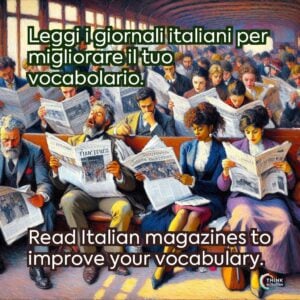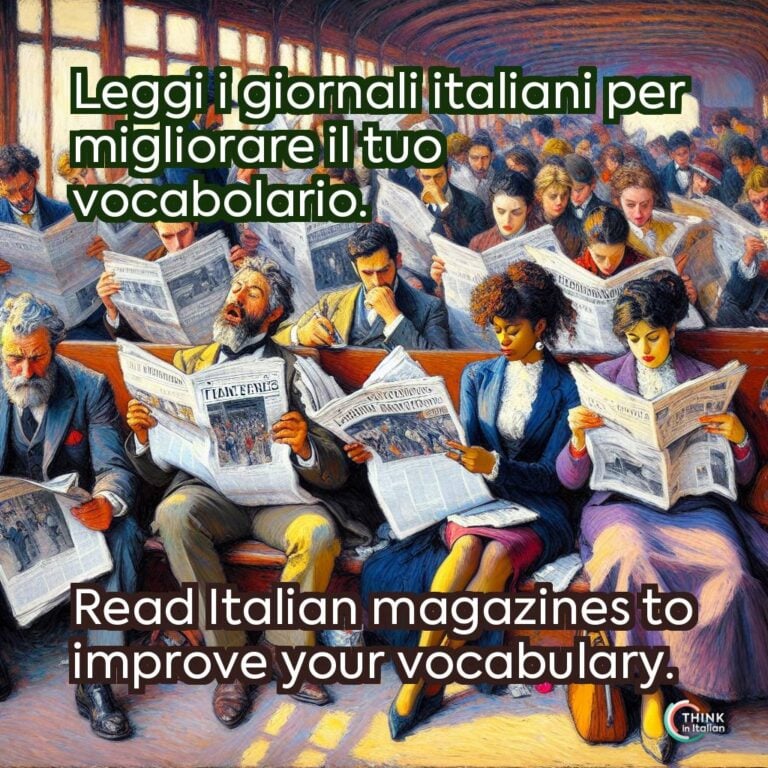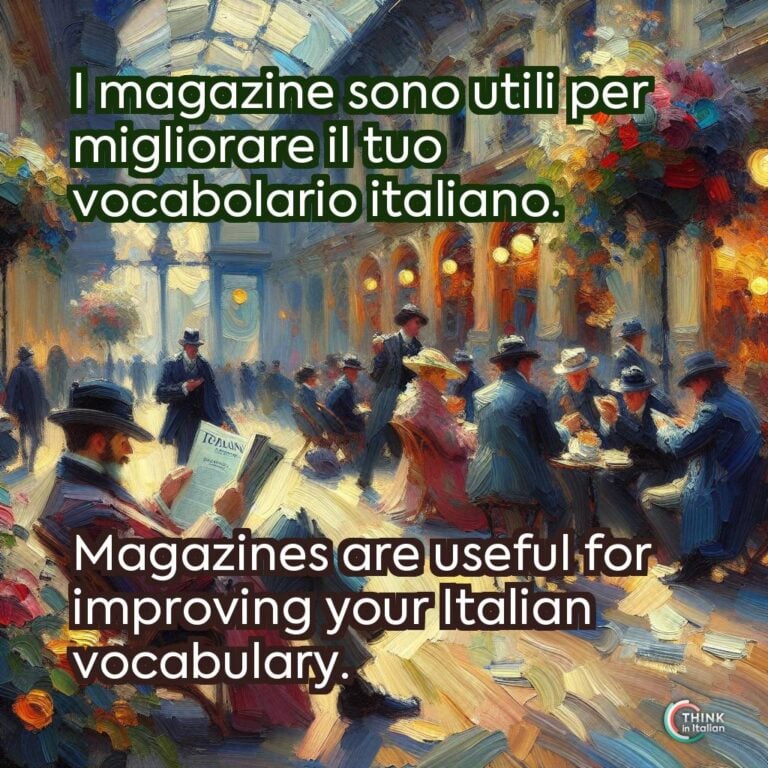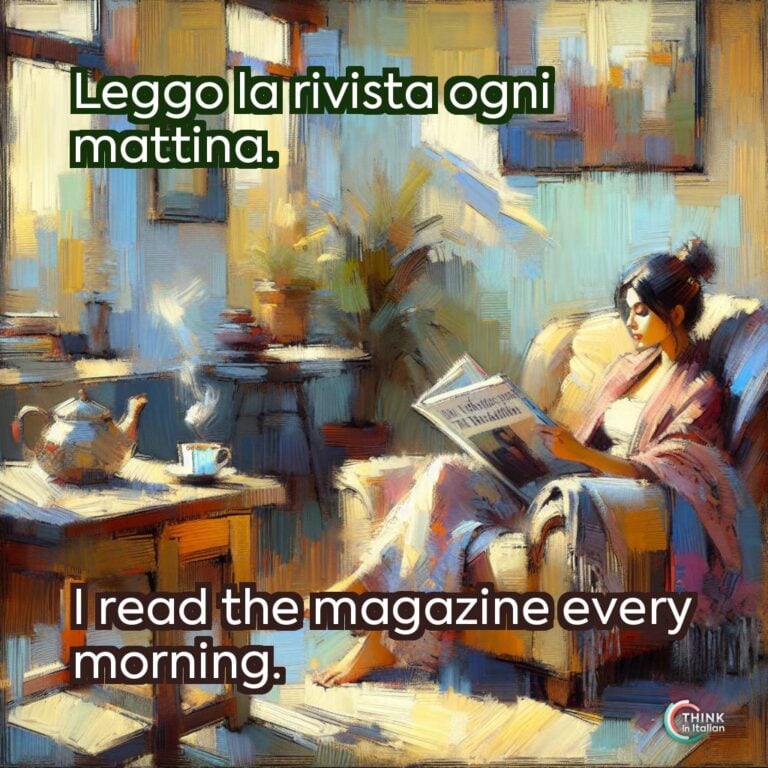Benefits of Reading Italian Magazines
Vocabulary Building
Magazines introduce you to the actual vocabulary and expressions one comes across in various contexts, like interviews, recipes, reviews, and opinion columns.
Moreover, they cover a wide range of topics, introducing you to words and phrases related to politics, art, fashion, science, cuisine, and more.
Such practical vocabulary will make you more confident in joining conversations and will expose you to everyday expressions and idiomatic expressions which usually are not taught in textbooks.
This thematic variety allows you to strengthen your vocabulary and speak about every topic with great confidence. They present a very good chance of learning how to use language contextually.
Grammatical Improvement
Since magazines are written professionally and then carefully edited, they are very reliable sources of well-structured and grammatically correct Italian.
Reading them on a regular basis reinforces the proper sentences structure, verb conjugations, and punctuation usage, thus giving one a natural way to internalize Italian grammar.
Cultural Insights
Italian magazines are the passports to the rich culture and diversified lifestyle of the country.
Be it its cuisine, traditional festivals, or contemporary fashion and politics, they provide a glimpse into the customs, values, and viewpoints cherished by Italians.
By exploring these cultural elements, you’ll not only learn the language but also develop a greater appreciation for the Italian way of life, making your learning experience more enriching and well-rounded.
Improved Reading Speed
Magazines are the prime source to enhance your speed and comprehension with their small articles, eye-catching pictures, and easy layouts.
Variety nurtures interest in continuing to read, while accessibility within the format allows the absorption of the language at your chosen speed and without overwhelming difficulty.
Flexibility and Entertainment
Unlike thick novels or long-form newspapers, the articles in magazines are quick, engaging, and easily manageable. Their short form makes them perfect for squeezing language practice into a busy schedule.
You can read one over your morning coffee, on your commute, or while you relax in the evening. Most magazines approach subjects with a conversational tone, which makes them an enjoyable way to work on your Italian without frustration.
Also, they couple language learning with entertainment. The learning process becomes a pleasant activity since it keeps you engaged and widens your knowledge about Italian.
Exposure to Various Writing Styles
Each magazine has its way and tone, from formal reporting in news magazines to a relaxed tone in fashion or lifestyle publications.
All this exposure helps you adapt to different kinds of texts and helps you improve your skills in understanding and interpreting Italian in different contexts and genres.
This is how you train your brain for everything from academic Italian to conversational language.
Best Italian Magazines for Learning Italian
News and Current Affairs
- L’Espresso
- What it offers: a progressive weekly magazine that delves into politics, culture, society, and in-depth investigative reporting. Each issue provides critical perspectives on Italian and global issues, often featuring long-form articles and thought-provoking editorials.
- Why it’s great: it is ideal for advanced learners who want to deepen their understanding of Italian current affairs while expanding their ability to engage with complex topics.
- La Repubblica
- What it offers: it covers a wide array of topics, including politics, sports, economics, and cultural trends. It often includes feature stories, opinion pieces, and interviews that provide a well-rounded view of contemporary Italy.
- Why it’s great: its clear and entertaining language makes it an excellent resource for learners who want to begin to know about Italian society on a deeper level.
- Il Corriere della Sera
- What it offers: it is one of Italy’s oldest and most respected newspapers, established in 1876. It is known for its in-depth national and international news coverage, but it has sections on culture, lifestyle, and sports, aside from the rigorous political reporting.
- Why it’s great: perfect for advanced learners looking to improve themselves with detailed, factual reporting. Its historical importance, as well as wide readership, represent an invaluable resource in discovering both traditional and modern Italian.
Fashion and Lifestyle
- Vogue Italia
- What it offers: monthly insight into Haute Couture, beauty, and culture. It offers privileged access to what’s new in high fashion, luxury, and celebrity styles.
- Why it’s great: it reflects Italian elegance and cultural deepness. Its articles combine a high dose of creativity in storytelling and are always up-to-date.
- Grazia Italia
- What it offers: weekly fashion and lifestyle tips, everything from beauty trends and celebrity news to tips for chic everyday styling.
- Why it’s great: its accessible tone and very approachable content is perfect for intermediate readers who need to stay updated on the latest and greatest without getting overwhelmed.
- Marie Claire Italia
- What it offers: fashion, health, and women’s empowerment. A lifestyle featured magazine that carries in-depth articles on social issues and personal growth.
- Why it’s great: it is great for its astute observations of gender equality and the challenges faced by modern women. Also Italian art, music, and food are covered which make this an overall cultural package with practical advice.
Culture and Arts
- Il Giornale dell’Arte
- What it offers: monthly coverage of art events, museum news, and interviews with artists. For those into art and cultural preservation, this is a real treasure trove.
- Why it’s great: it covers Italy’s great artistic heritage in depth, perfect for enthusiasts of art to extend both their vocabulary and cultural knowledge related to Italy.
- Artribune
- What it offers: articles on art, cinema, and literature, plus information on all the upcoming exhibitions and cultural events in Italy.
- Why it’s Great: it covers not just the visual arts but larger cultural topics like music and literature. Its catchy articles make it perfect for learners interested in exploring Italy’s vibrant cultural scene while improving their language skills.
Science and Nature
- Focus
- What it offers: science, history, and innovation, all clearly and interestingly explained to help learners diversify into more technical topics.
- Why it’s great: it has a good balance between simplicity and depth, perfect for intermediate learners interested in improving vocabulary regarding scientific subjects such as science, the environment, and technology.
- National Geographic Italia
- What it offers: stories about nature, adventure, and Italian landscapes with spectacular photography.
- Why it’s great: it displays both amazing photography and well-penned articles. Perfect for students in love with the environment interested in traveling to a place through language.
Food and Culinary Arts
- La Cucina Italiana
- What it offers: recipes, cooking tips, and gastronomic culture -how the Italian dining tradition is, its techniques, among others.
- Why it’s great: it targets food lovers who want to enlarge their gastronomic vocabulary while learning how to prepare authentic Italian dishes. Recipes are exhaustive yet approachable, therefore practical for learners.
- Giallo Zafferano
- What it offers: Italian recipes with step-by-step instructions and accompanying pictures.
- Why it’s great: ideal for beginners who would like to combine their love of cooking with language learning due to its clear and at the same time practical language. The fun and interactive way to dive into Italian culture.
Comics and Puzzles
- Topolino
- What it offers: comic stories with Disney characters, entertaining storylines, and simple dialogues.
- Why it’s great: it is the fun way of reading and learning Italian, especially at a beginner level. Everyday vocabulary and idiomatic expressions in the text will help improve comprehension and have fun reading light stories.
- La Settimana Enigmistica
- What it offers: crosswords, riddles, and word games that challenge your vocabulary and logical thinking.
- Why it’s great: it offers a fun and interactive way to learn through activity-based learning. These puzzles help in solidifying your vocabulary and grammar while maintaining fun throughout the learning process.
Tips for Using Italian Magazines to Learn
Begin with Headlines
Headlines are brief, concise, and usually planned to attract the attention of a reader. They are also very good starting points, as they use straightforward effectual language.
Scan headlines for finding important vocabulary and to get an idea of what the major topics are. Try to work out a meaning for unknown words in context before referring to them.
Highlight new Words
Keep a highlighter or a pencil handy while reading. Annotate unfamiliar words, phrases, or idioms, and write their meanings in the margins or a notebook.
Revisit these annotations regularly to reinforce your memory and build a personalized vocabulary bank. Over time, you’ll notice many words reappearing, which will help solidify their meanings.
Read Aloud
Reading articles aloud not only improves your pronunciation and intonation but also helps internalize the rhythm of Italian sentences.
Pay attention to how words flow together and practice emphasizing key phrases. This exercise can boost your confidence when speaking and make your Italian sound more natural.
Summarize in Italian
After you read an article, either write or tell in short what you read, using your own words. It reinforces your understanding and allows you to remember vocabulary and grammar structures.
For example, after reading about a festival that is going to take place, you can say ho letto di un festival che si terrà a Roma il prossimo weekend (I read about a festival that will take place in Rome next weekend).
Look for Regional Magazines
Italian regionalism is represented in the magazines, often with local customs, dialects, and traditions. Reading magazines from specific regions, such as Tuscany or Sicily, you are exposed to unique vocabularies and cultural nuances.
For example, a magazine from Naples might introduce Neapolitan expressions, while one from Milan could be about northern Italian trends. This will enrich not only your language but also your cultural understanding of the regional identities in Italy.






